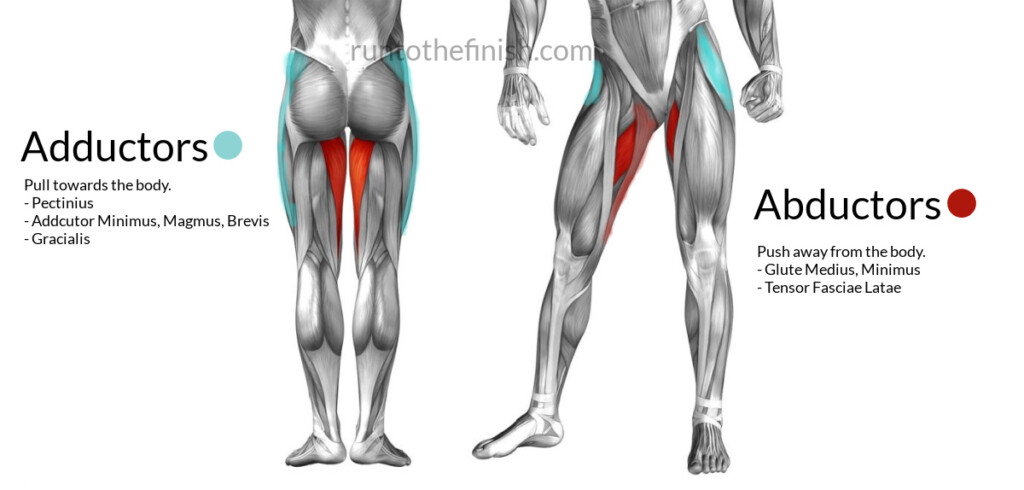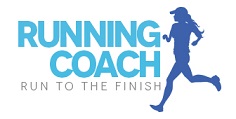Unless you’ve dealt with an injury in your upper leg or you’re spending more time in the gym strength training you might not have used these terms much. Which is why adductors vs abductors can leave us a bit confused, so we’re going to clear it up and understand what they do for your runs, plus how to strengthen them.
As a running coach, I’m interested in them because they occasionally relate to an injury and we want to resolve it. But also because understanding how to work your lower body is massively important for our goals.
Yes, there’s literally only a one-letter difference between the words but the muscle groups do opposite things.
The abductor and adductor muscles in your hips and thighs work together to allow side-to-side leg movements. Your abductor muscles move your leg away from the midline of your body, while your adductor muscles bring it back towards the midline.
Yes, training these muscles specifically is beneficial to you as an athlete, not just for bodybuilding.
So let’s dive a little deeper here into these important running muscles, what they do, common issues runners may have, and how to resolve them.
What are the Adductors?
The adductors are made up of the adductor longus, brevis, magnus, and minimus, as well as the pectineus, gracilis, and obturator externus. Whoo, that’s a mouthful! I promise there is no quiz.
This muscle group helps to stabilize the hip and pelvis and adduct the thigh (move your leg TOWARDS your body).
They’re also involved in hip flexion, extension, and rotation too. They’re mostly all located on the inside of the thigh.
There are a couple easy ways to remember the difference between the adductors and abductors.
- There are 2 d’s in adductors. One way to remember is to think of the second “d” as an abbreviation for “decrease.” The adductors decrease the space between your legs by bringing them together.
- Another way to remember the difference is that adductors “add.” They bring the legs together, adding one to the other.
What do the Adductors Do While Running?
Meanwhile, the adductors, while also important for stabilization, help with running efficiency, impaction absorption, and hip extension to power your stride.
We often associate the adductors with groin pain after running. A 2018 study looking at soccer players, showed those in the adductor strengthening group reported a 41% lower risk of groin problems compared to the control group.
While we aren’t making quick side to side movements, groin strains aren’t uncommon to runners and it looks like a little strength work might be the key to avoiding it!
In addition, they help keep your hips level as you run so your hips aren’t dropping to one side or the other. Weak adductors that can’t help with that stabilization can lead to injuries and issues throughout your kinetic chain, including in your knees, groin, and ankles.
Adductor Injuries
Adductor tendinopathy or adductor strain are two of the common issues athletes can face, particularly those playing soccer, hockey, and rugby. According to Dr. Nelson, the groin endures significant loads in these sports because of frequent direction changes and kicking.
When the groin is weak, particularly significantly weaker than the abductors, athletes are at a much greater risk of injury.
While there are a few other options, these are the most likely culprits of pain.
What are the Abductors?
The abductors are on the outside of the thigh and are part of the glutes. They are made up of the gluteus medius and gluteus minimus. Strengthening these muscles help contribute to having a nicely shaped outer glute, aka your bum.
These muscles, as mentioned, help move your hip and legs AWAY from your body’s midline.
Dr. Alex Nelson, a physical therapist, offered an fun way to remember what the abductors do. “A quirky way to remember this is by thinking of “abduction” like aliens taking someone away.”
These muscles serve to stabilize the pelvis, particularly during single-leg activities, including walking, running, and climbing stairs.
What do the Abductors Do While Running?
Yes, you absolutely use these muscles to run.
The abductors are important to the stabilization of the pelvis during single-leg activities, a key component of preventing knee pain while running! In fact, a 2011 study found that after just three weeks of hip abductor training, runners with patellofemoral syndrome (runner’s knee) experienced increased strength and reduced pain.
Abductor Injuries
Gluteal tendinopathy and lateral hip pain are some of the main issues runners may face, especially women.
“Running consistently places substantial load on these gluteal muscles and tendons,” explained Dr. Nelson. “If the frequency, volume, and intensity of runs exceed one’s capacity for recovery and adaptation, gluteal tendinopathy may develop.”
Dr. Nelson said usually when runners experience these issues, there is a training load imbalance. Basically, you’re engaging in more physical activity than your body can handle at a given time. However, it’s also important to be aware of your overall health. There are several lifestyle and metabolic issues that can impact tendon health, including diabetes, hypercholesterolemia, adiposity, and even the use of certain medications.
How to Strengthen the Abductors and Adductors?
With how common adductor and abductor issues can be and how they can lead to injuries elsewhere in the kinetic chain, it’s important that runners and athletes of all kinds take steps to prevent them.
You all know I love my warm-ups and Dr. Nelson is also an advocate for taking the time to properly warm up before a workout or run. If you don’t know where to start, checkout these guided pre-run stretches to keep it dynamic and mobile, not static.
He also is a firm believer in focusing on effective load management, staying consistent with strength training, maintaining a regular sleep schedule, and proper nutrition.
He also stressed that research consistently supports strength training as a way to reduce sports injuries and reduce overuse injuries too.

General Strength Training
Any time you do a squat, a lunge, a step up, you’re asking your adductors and abductors to help stabilize you. So they are always getting worked in some ancillary way, but it’s great to also do some focused work on them.
Pilates classes are also going to be a great options for hitting these areas with that endurance feel! But remember we need both endurance and strength.
Adductor Strength Training Movements
Here are some movements to target that inner thigh, adductor area:
- Lying side leg lifts – You might need to start here if coming back from an injury and high reps can burn!
- Copenhagen planks – Work through this from easy with bottom knee on ground, too both knees up, to straight legs
- Sumo Squats – Toes pointed outward and if holding a weight between legs, pause at the bottom
- Adductor Machine – You might think of this as the inner thigh machine where you are pushing the pads together (yup thigh master is working it too!
- Side Lunges – Lateral lunges or side lunges are going to work both your standing quad and adductor
Abductor Strength Training Movements
Here are some movements to target that outer hip, abductor area:
- Fire hydrants – Standing with mini band above the knees, well pretend like your a pup next to a fire hydrant
- Curtsy Lunge – You can progress this both with weights and by using a step.
- Standing Hip Abduction – Great if you have a cable machine, otherwise mini band around the ankles, keep one leg stationary with slight bend and then lift the other straight leg out to the side
- Abductor Machine – Yup flip those pads around so that you are pushing out from the middle of the body
You did not see clamshells on this list because a few studies have shown they are inferior to most other movements for actually building strength.
Feeling Pain? What Should You Do?
Are you feeling tightness in your adductors or abductors after or during runs? What about other discomfort or pain?
If so, you might be wondering what to do next.
I, myself, have dealt with adductor issues and when rest didn’t solve the issue, I headed to the physical therapist for help. This is especially important if your pain is impacting your performance, affecting other daily activities, and simply won’t go away.
There’s only so much that stretching, rest, and anti-inflammatories will do on their own. In general, rest will NOT resolve a running injury.
“Tendons thrive on exercise and movement, but it requires the right progression,” said Dr. Nelson. “A physical therapist can guide you through the proper exercises, help you understand and monitor your pain, modify activities, and rule out other conditions.”
“It’s crucial to adjust the frequency, volume, and intensity of your runs to find a manageable starting point and load that you can recover from,” he said. “Finding this proper training dosage will be one of the biggest factors in reducing risk of injury and keeping the tendons feeling happy.”
It’s important to note that like many other types of injuries, there is no quick fix for tendinopathy. Recovery will take time and having someone guiding your rehab can prevent you from spending more time on the sideline than if you try to manage things on your own.
As a run coach, I can vouch for Dr Nelson and highly recommend you reach out if you’ve been struggling through a tendon issue!
Hopefully this gave you more than you expected on adductors vs abductors and now you feel more prepared to go out and strength train them the right way! Of course, our team of run coaches also provides custom strength work to our athletes if you’re still feeling overwhelmed with how to put all the running pieces together.
Other ways to connect with Amanda
Instagram Daily Fun: RunToTheFinish
Facebook Community Chatter: RunToTheFinish
Sign Up to Receive a Weekly Newsletter with Top Running Tips and Laughs

